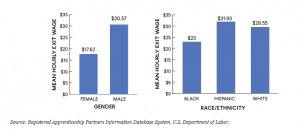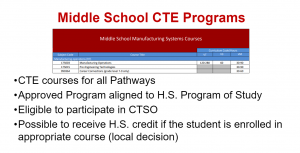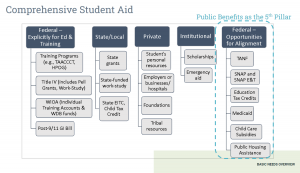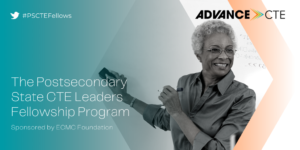![]() Advance CTE’s “Research Round-Up” blog series features summaries of relevant research reports and studies to elevate evidence-backed Career Technical Educational (CTE) policies and practices and topics related to college and career readiness. This month’s focus supports a vision for the future of CTE where statewide systems and institutions effectively support each learner to earn credentials that are counted, valued, and portable.
Advance CTE’s “Research Round-Up” blog series features summaries of relevant research reports and studies to elevate evidence-backed Career Technical Educational (CTE) policies and practices and topics related to college and career readiness. This month’s focus supports a vision for the future of CTE where statewide systems and institutions effectively support each learner to earn credentials that are counted, valued, and portable.
Two recent reports from JFF and New America highlight the benefits of different workforce development programs; apprenticeships and work-based learning (WBL), and the opportunity to increase equitable access to these programs for every learner.
Addressing disparities in apprenticeship participation may fast-track non-traditional learners into living wage jobs.
JFF’s Center for Apprenticeship & Work-Based Learning published a report analyzing young people’s apprenticeship participation through an equity lens. The Current State of Diversity and Equity in U.S. Apprenticeships for Young People utilizes data from the U.S. Department of Labor’s Registered Apprenticeship Partners Information Database System to analyze youth apprenticeship participation from fiscal years 2010-2020.
- This report showed that, in total, 389,8860 young people (ages 16-24) started a Registered Apprenticeship program between 2010-2020. This rate outpaced overall youth employment.
- The average exit wage of $30 per hour for young people completing apprenticeships is much higher than the median wages among all young people, which suggests that work-based learning facilitates movement into well-paid jobs.
- The data demonstrate that learners participating in apprenticeships are more likely to be white than non-white (63 percent compared to 35 percent) and more likely to be male.
Average Hourly Exit Wage by Gender and Race/ Ethnicity for All Youth Participants in Apprenticeships, FY 2010-2020

- This report identified “occupational segregation” as the explanation for the drastic differences in exit wages across lines of race and gender. For example, the data showed that the top occupation for female learners, pharmacy technician, paid $12 per hour compared with $26 per hour for the top male occupation of electrician. Similarly, these findings suggest that Black apprentices’ average exit wage of $23 (compared to $32 for Hispanic workers and $30 for white workers) is likely attributable to the large share of Black apprentices participating in heavy trucking and tractor-trailer programs, which paid $18 in exit wages.
- This report noted the shared benefits of increasing equitable access to workforce training programs: “When employers tap into a broader swath of talent, they often see a positive return on investment via healthier bottom lines and greater innovation, thanks to the wide range of backgrounds and experiences these apprentices bring to the job.”
Paid, postsecondary work-based learning pilot programs may be an effective tool for improving learner retention.
New America recently published case studies of postsecondary institutions that have piloted paid work-based learning programs. This report, “What Everyone Should Know about Designing Equity-Minded Paid Work-Based Learning Opportunities for College Students” highlights the findings from case studies of emerging paid WBL program models across the country to understand the motivation, goals, and design of paid WBL opportunities available at two-year colleges. The findings include implications for state policymakers and college stakeholders in career services, academic advising, and workforce development.
- Paid WBL programs appear to correlate with improved learner retention strategy. Learners appear to value and engage more in paid WBL opportunities on campus or in the local community since transportation was previously an obstacle.
- Institutions featured in these case studies funded paid WBL programs through multiple sources, from Higher Education Emergency Relief Funds (HEERF), Pell grants to supplement student employment, and internal funding sources from the institution’s general operating budget.
While the learner populations across these reports vary, common themes can be drawn from the key findings of these two reports:
- Workforce programs benefit participants by increasing earnings and providing opportunities to gain in-demand skills, and in turn, these benefits are also enjoyed by adjacent stakeholders, including employers and postsecondary institutions.
- Understanding learner barriers can create more equitable access for underrepresented learners in these programs.
- Braiding funding sources can allow states to design more equitable programs and supports that facilitate young adults’ transition into competitive wage jobs.
- States and postsecondary institutions still need support in collecting data on longitudinal workforce outcomes for those who complete work-based learning and apprenticeship programs.
Additional Resources
- Train the Trainer: Opportunity Gap Analysis Workshop
- The Building A Youth Apprenticeship Data Ecosystem Starter Kit
- Connecting Every Learner: A Framework for States to Increase Access to and Success in Work-Based Learning
Amy Hodge, Policy Associate


 Congress Focuses on Midterms, Will Return Next Month
Congress Focuses on Midterms, Will Return Next Month Career advising and development supports geared towards middle grades learners to improve access and achieve high-quality and equitable secondary CTE programs prove to be an early opportunity to develop an occupational identity and better build social capital. Ohio discussed the policy structures the state has put into place to support learners in CTE programs before they enter high school, including funding mechanisms and alignment of middle grades programs of study. Michigan Advance CTE-ECMC Fellow
Career advising and development supports geared towards middle grades learners to improve access and achieve high-quality and equitable secondary CTE programs prove to be an early opportunity to develop an occupational identity and better build social capital. Ohio discussed the policy structures the state has put into place to support learners in CTE programs before they enter high school, including funding mechanisms and alignment of middle grades programs of study. Michigan Advance CTE-ECMC Fellow  An education consultant and a state leader from Wisconsin provided an overview of programs that support learners basic needs, while elevating that many programs still create barriers for learners to complete credentials. Immediate next steps that were shared included making integrated benefits applications for federal assistance programs available online and inviting benefits coordinators to provide services on campus. Wisconsin highlighted their steps to create affinity groups with faculty and staff, with Dr. Colleen McCabe stating “To understand the effects of poverty, you have to explore learners’ multiple identities.”
An education consultant and a state leader from Wisconsin provided an overview of programs that support learners basic needs, while elevating that many programs still create barriers for learners to complete credentials. Immediate next steps that were shared included making integrated benefits applications for federal assistance programs available online and inviting benefits coordinators to provide services on campus. Wisconsin highlighted their steps to create affinity groups with faculty and staff, with Dr. Colleen McCabe stating “To understand the effects of poverty, you have to explore learners’ multiple identities.” The Delaware Department of Education recently named Jon Wickert as its new Director, Career and Technical Education (CTE) and Science, Technology, Engineering, and Mathematics (STEM) Initiatives. His path to state CTE leadership reflects the power of career exploration and social capital that will sustain ‘The First State’s’ strong record of innovation and transformation of CTE systems.
The Delaware Department of Education recently named Jon Wickert as its new Director, Career and Technical Education (CTE) and Science, Technology, Engineering, and Mathematics (STEM) Initiatives. His path to state CTE leadership reflects the power of career exploration and social capital that will sustain ‘The First State’s’ strong record of innovation and transformation of CTE systems.  Carlos Lopez (Colorado) has over a decade of experience as an instructor, program coordinator and academic advisor at secondary and postsecondary institutions focused on historically marginalized learners. Carlos currently serves as the Associate Dean for the College of Health Sciences and Administration at Emily Griffith Technical College. They earned a bachelor’s degree in Psychology from Metropolitan State University of Denver and master’s degrees in Liberal Arts and Education Leadership and Policy Studies, Higher Education from St. John’s College – Santa Fe and University of Texas – San Antonio, respectively.
Carlos Lopez (Colorado) has over a decade of experience as an instructor, program coordinator and academic advisor at secondary and postsecondary institutions focused on historically marginalized learners. Carlos currently serves as the Associate Dean for the College of Health Sciences and Administration at Emily Griffith Technical College. They earned a bachelor’s degree in Psychology from Metropolitan State University of Denver and master’s degrees in Liberal Arts and Education Leadership and Policy Studies, Higher Education from St. John’s College – Santa Fe and University of Texas – San Antonio, respectively. Curtis Scales (Arkansas) began his career in management training in the healthcare industry and translated his passion for wellness and supporting underserved populations into a career in education. He currently serves as the Program Manager for Special Populations at the Arkansas Department of Education. He earned a bachelor’s degree in Recreation Administration from the University of Arkansas, and master’s degrees in Management and Leadership and Human Resource Management from Webster University.
Curtis Scales (Arkansas) began his career in management training in the healthcare industry and translated his passion for wellness and supporting underserved populations into a career in education. He currently serves as the Program Manager for Special Populations at the Arkansas Department of Education. He earned a bachelor’s degree in Recreation Administration from the University of Arkansas, and master’s degrees in Management and Leadership and Human Resource Management from Webster University. Dr. Dimitria Harding (Minnesota) has over 15 years of experience in the CTE field working as a cytotechnologist before pursuing a career in higher education. Dr. Harding currently serves as a Dean of Health Sciences and Career and Technical Education at Minnesota State College. She received a bachelor’s degree in Health Science and a master’s degree in Community Health from Old Dominion University, and a doctorate in Organizational Leadership.
Dr. Dimitria Harding (Minnesota) has over 15 years of experience in the CTE field working as a cytotechnologist before pursuing a career in higher education. Dr. Harding currently serves as a Dean of Health Sciences and Career and Technical Education at Minnesota State College. She received a bachelor’s degree in Health Science and a master’s degree in Community Health from Old Dominion University, and a doctorate in Organizational Leadership.
 The spring of 2020 saw postsecondary institutions close out semesters remotely due to COVID-19 (Coronavirus). The transition to distance learning was quick, forcing postsecondary systems and colleges to shift lesson plans and instruction methods in real-time. As the spring semester comes to a close, many colleges are expecting that the summer and fall semesters (at a minimum) will be delivered remotely as well- either in entirety or in some kind of hybrid.
The spring of 2020 saw postsecondary institutions close out semesters remotely due to COVID-19 (Coronavirus). The transition to distance learning was quick, forcing postsecondary systems and colleges to shift lesson plans and instruction methods in real-time. As the spring semester comes to a close, many colleges are expecting that the summer and fall semesters (at a minimum) will be delivered remotely as well- either in entirety or in some kind of hybrid.